Synthesis Analysis of One Severe Convection Precipitation Event in Jiangsu Using Ground-Based GPS Technology
Abstract
:1. Introduction
2. Case Study: 19–22 June 2009 Convective Weather Event
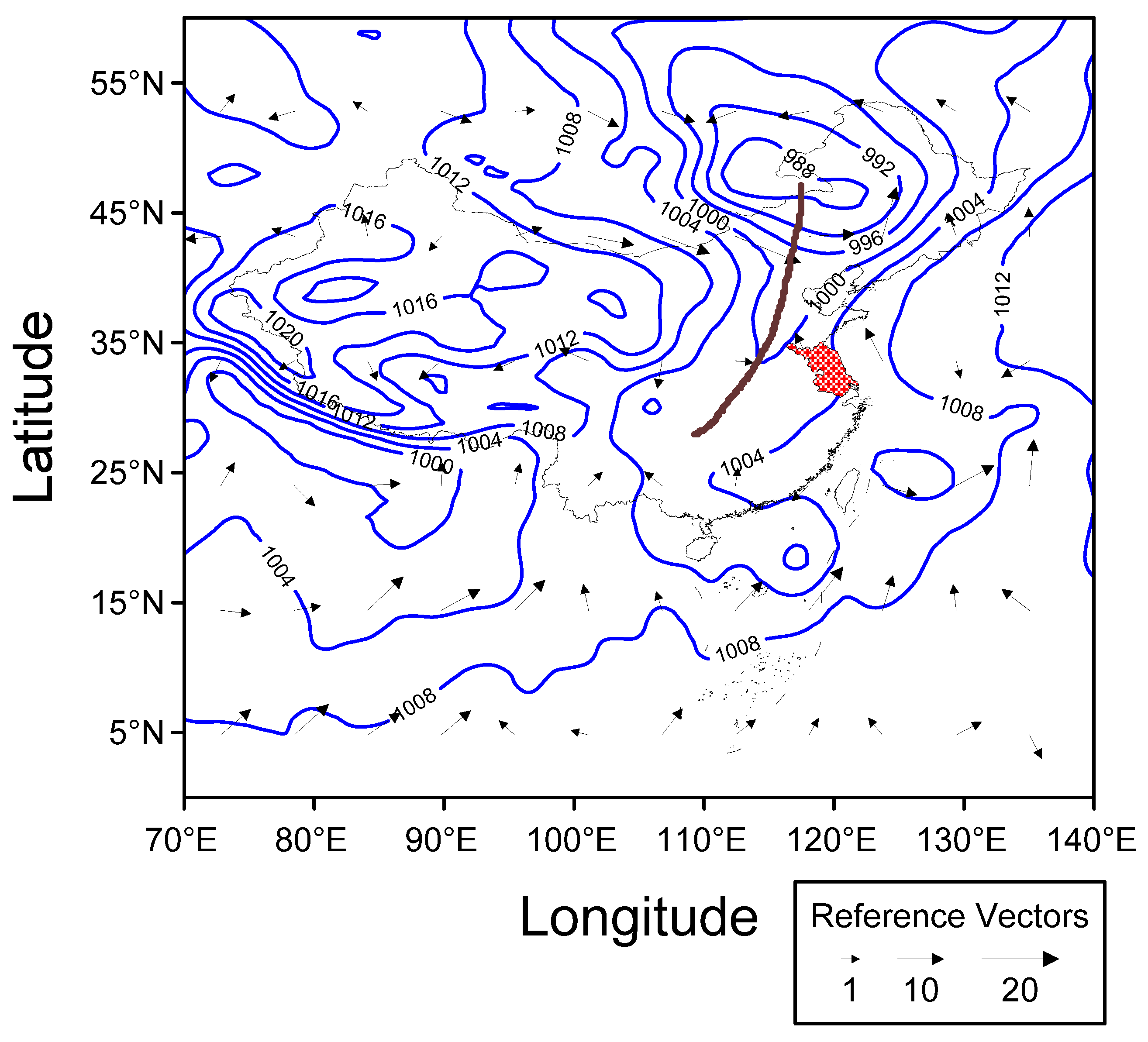
3. Data Acquisition and Calculations
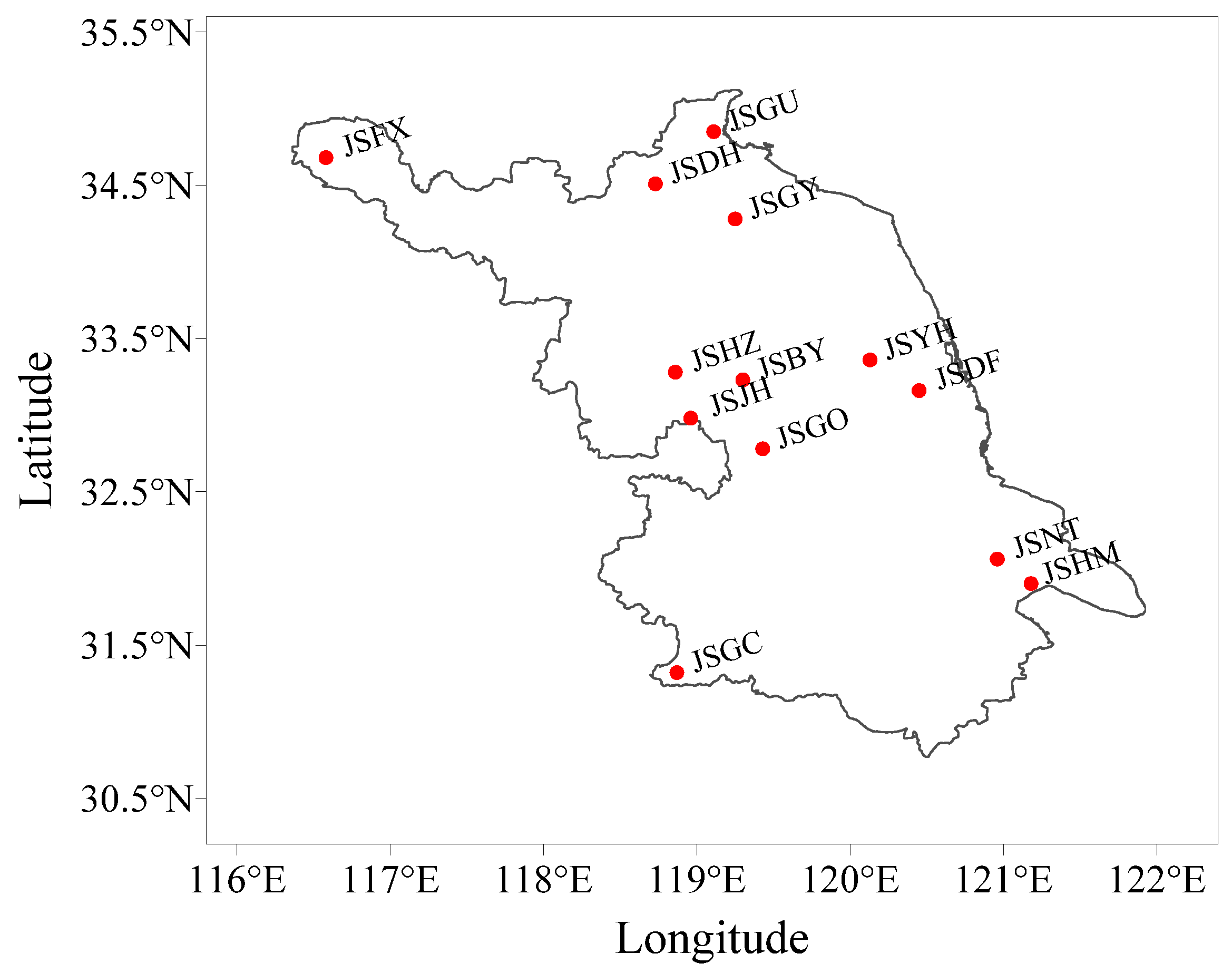
| Station | Longitude (°) | Latitude (°) | Altitude (m) |
|---|---|---|---|
| JSFX | 116.58 | 34.68 | 34 |
| JSGU | 119.11 | 34.85 | 10 |
| JSDH | 118.73 | 34.51 | 37 |
| JSGY | 119.25 | 34.28 | 19 |
| JSHZ | 118.86 | 33.28 | 14 |
| JSBY | 119.30 | 33.23 | 9 |
| JSYH | 120.13 | 33.36 | 34 |
| JSGO | 119.43 | 32.78 | 19 |
| JSJH | 118.96 | 32.98 | 28 |
| JSDF | 120.45 | 33.16 | 12 |
| JSGC | 118.87 | 31.32 | 19 |
| JSNT | 120.96 | 32.06 | 16 |
| JSHM | 121.18 | 31.90 | 16 |
4. Results and Discussion
4.1. Relationship between GPS-PWV and Precipitation
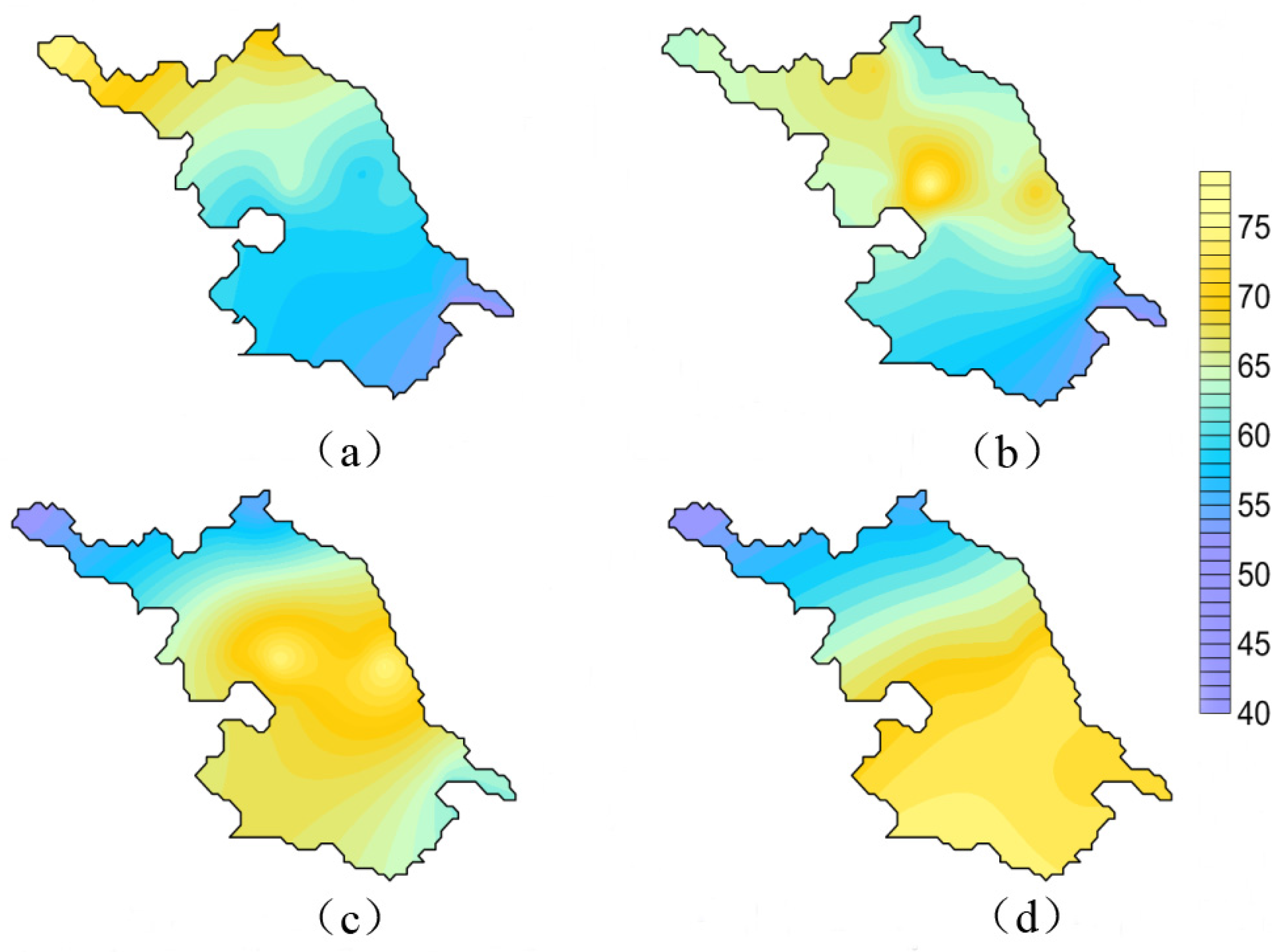
4.1.1. Accumulation Stage
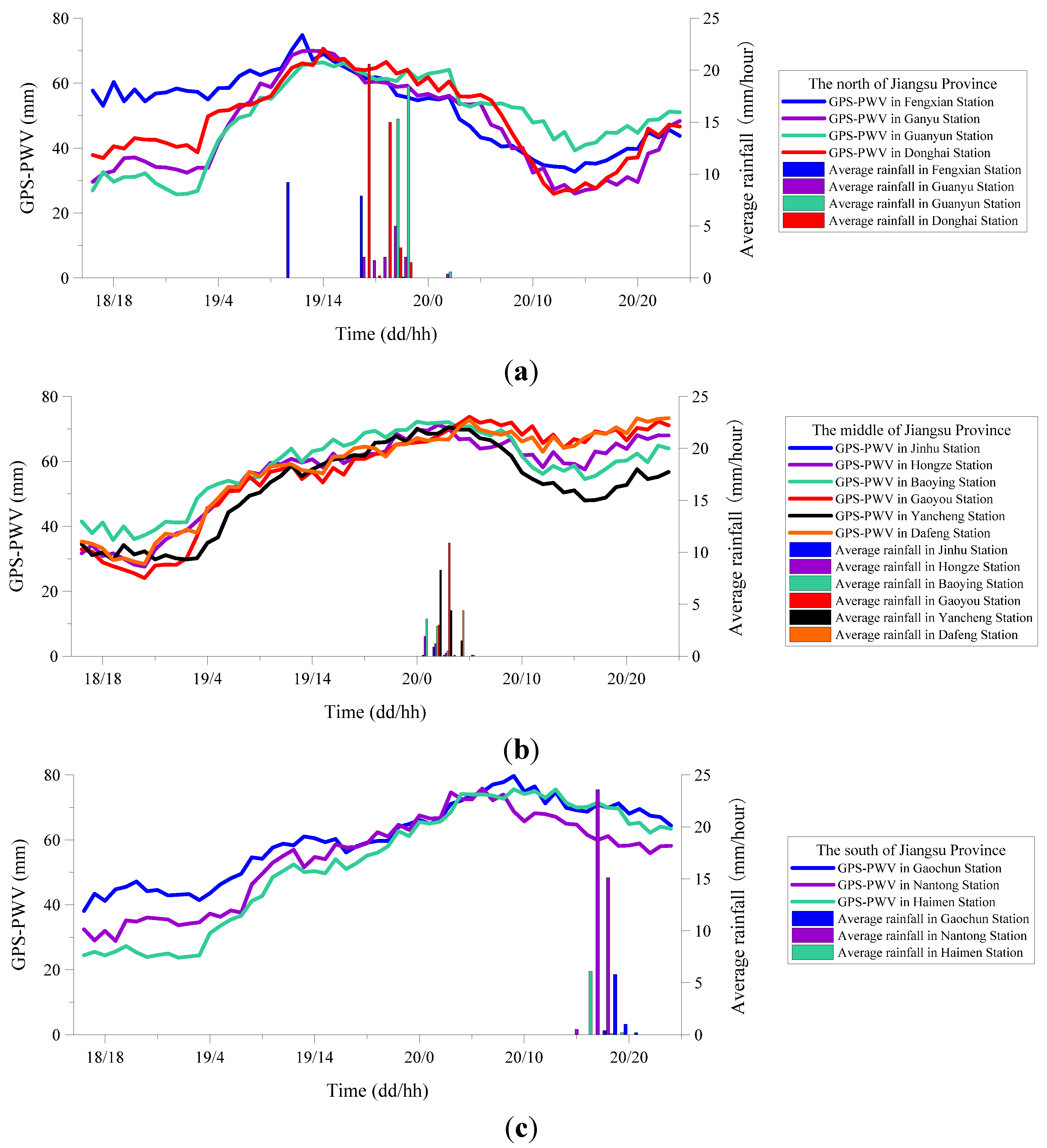

4.1.2. Releasing Stage
4.2. Physical Mechanisms
4.2.1. Water Vapor Distribution
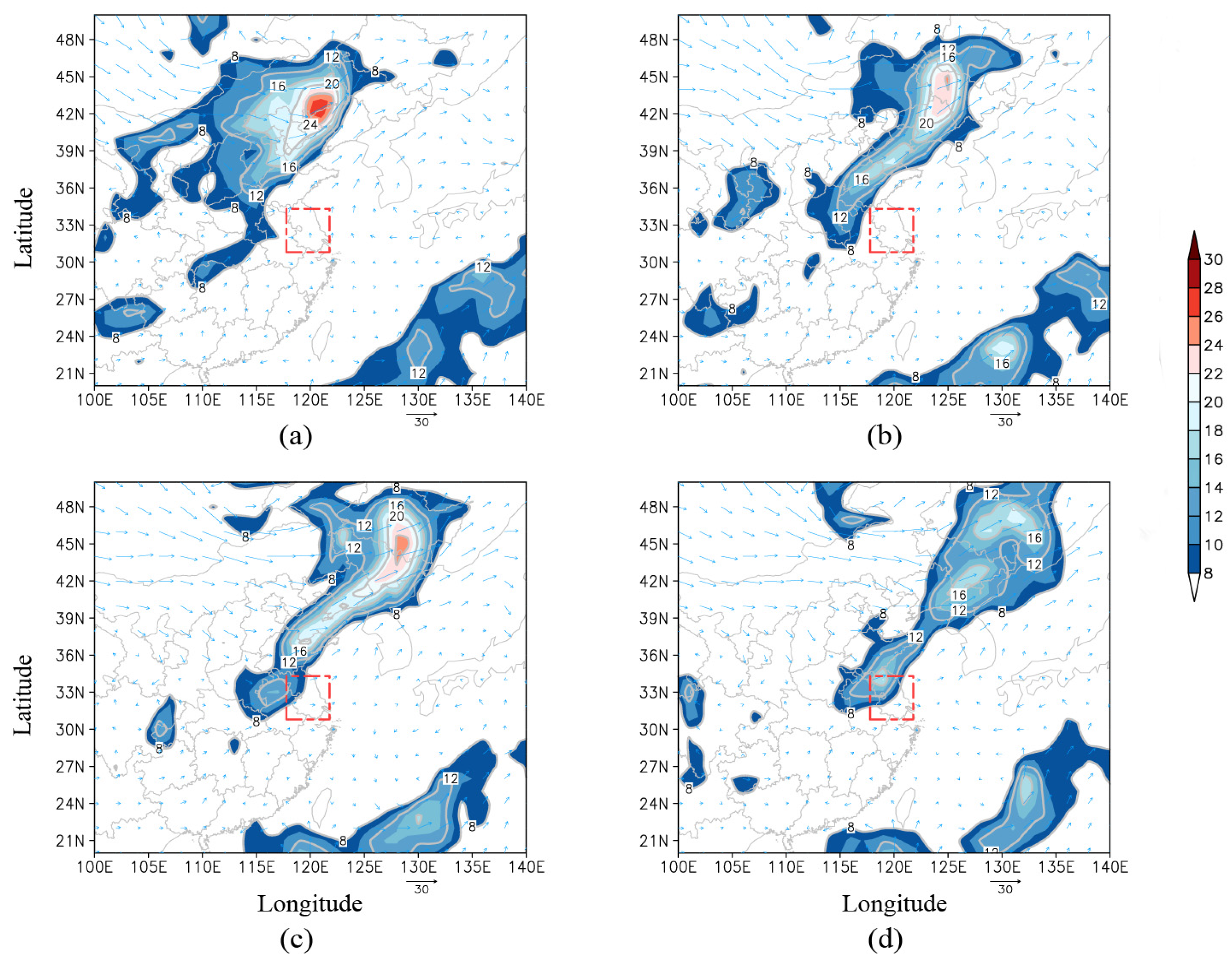
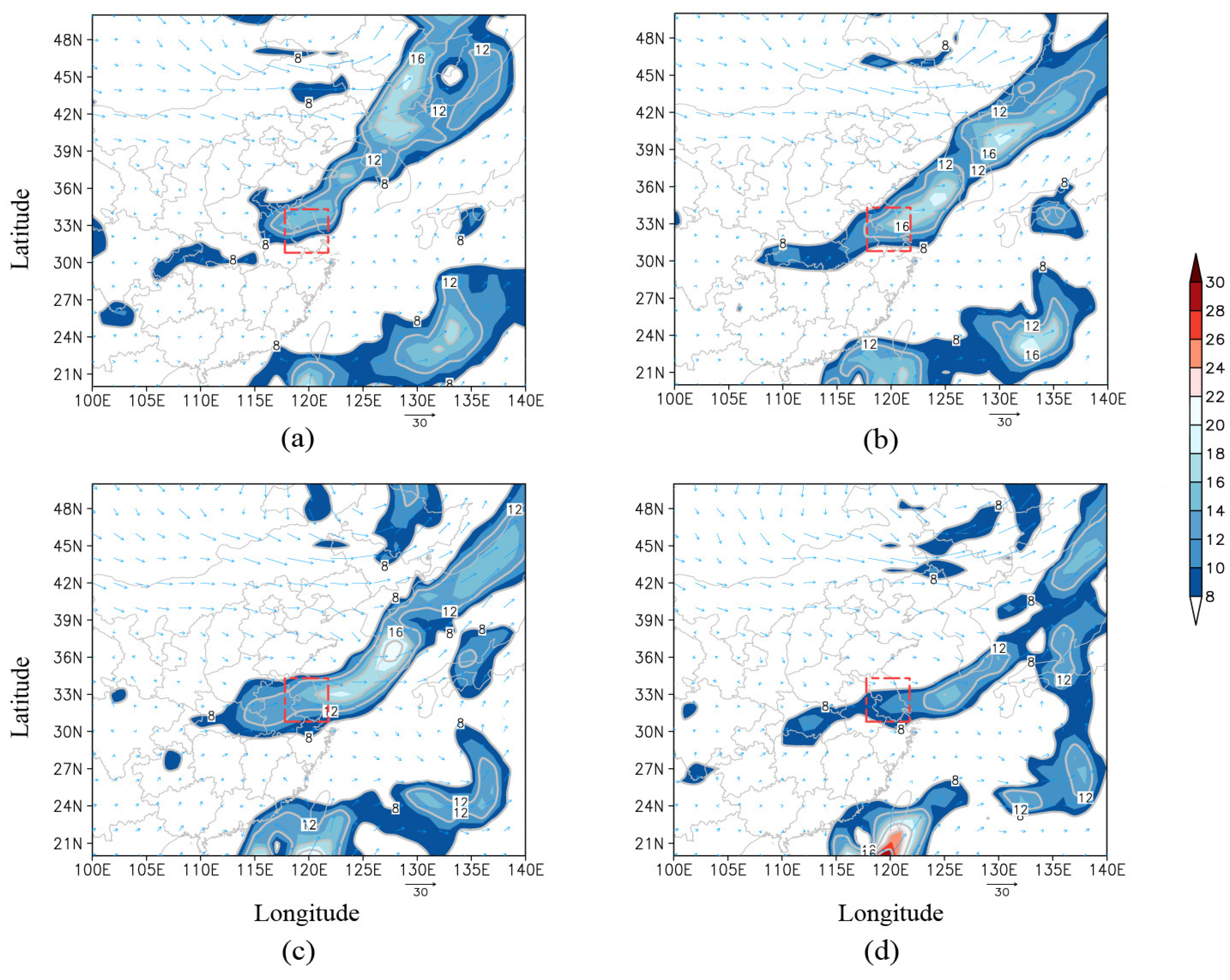
4.2.2. Thermodynamic Characteristics Stations
4.2.3. Dynamic Characteristics
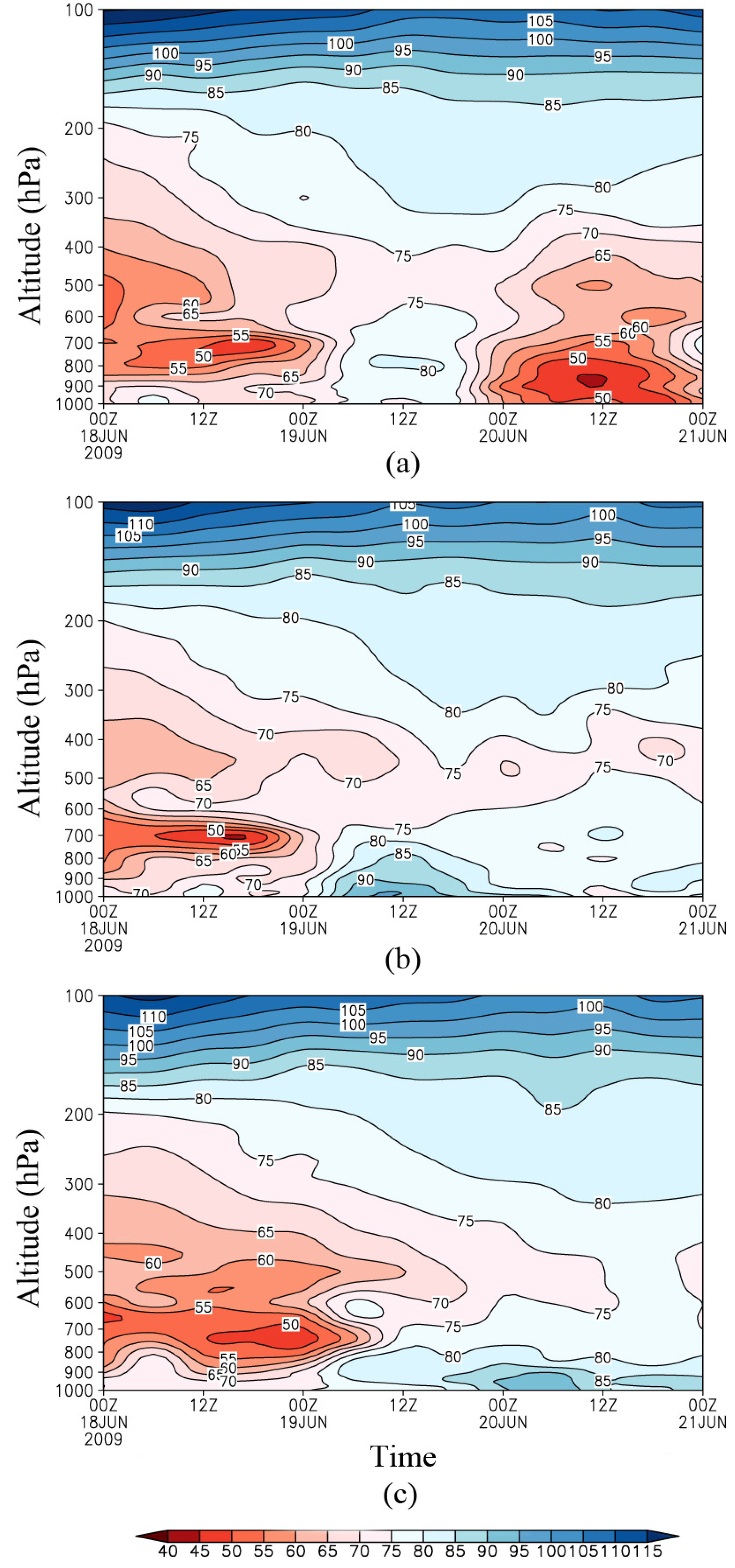


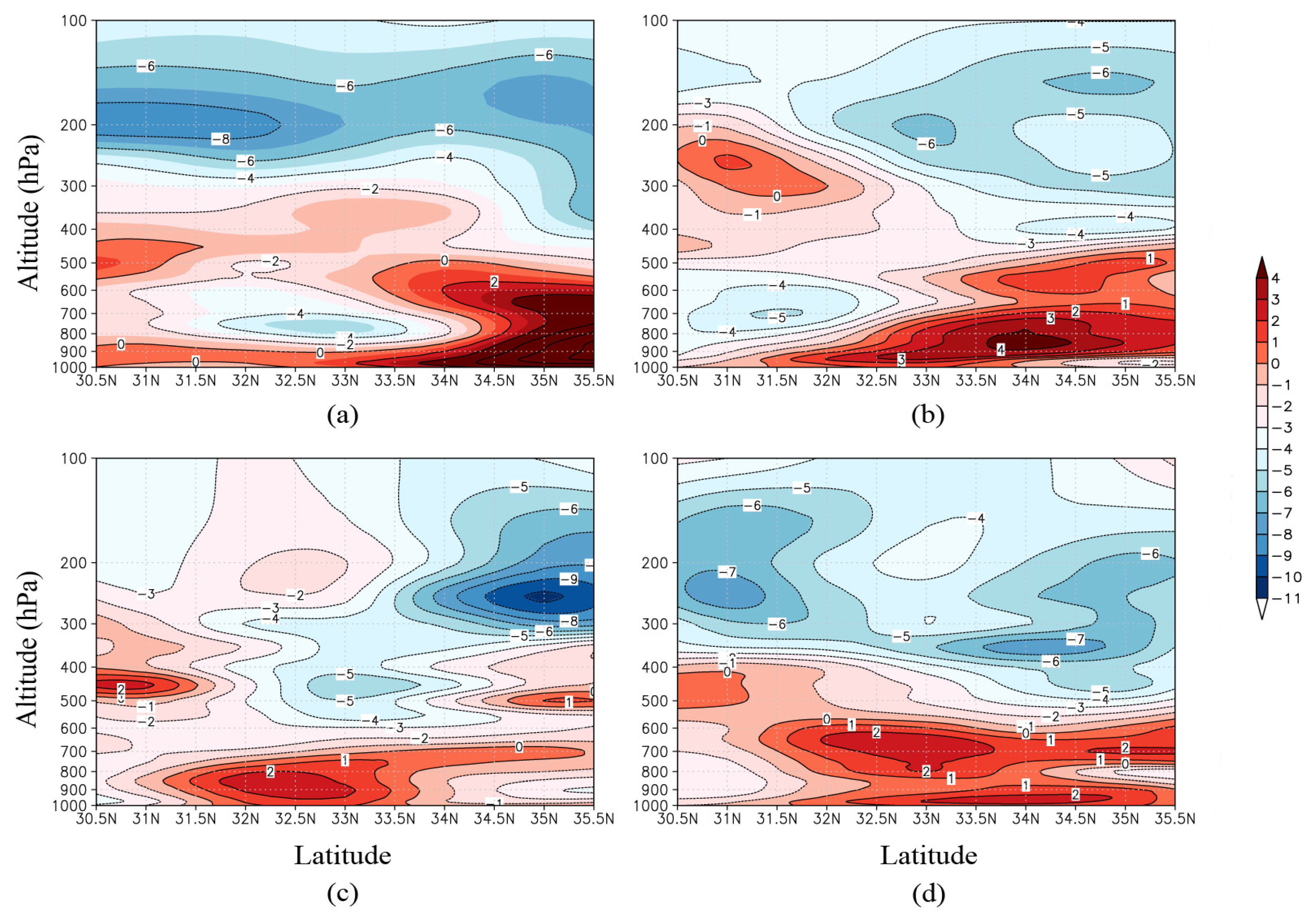
5. Conclusions and Future Research
Acknowledgments
Author Contributions
Conflicts of Interest
References
- Duan, J.; Bevis, M.; Fang, P.; Bock, Y.; Chiswell, S.; Businger, S.; Rocken, C.; Solheim, F.; van Hove, T.; Ware, R.; et al. GPS meteorology: Direct estimation of the absolute value of precipitable water. J. Appl. Meteorol. 1996, 35, 830–838. [Google Scholar] [CrossRef]
- Wang, H.; Wei, M.; Zhou, S. A feasibility study for the construction of an atmospheric precipitable water vapor model based on the neural network technology. Desalin. Water Treat. 2014, 52, 37–39. [Google Scholar] [CrossRef]
- Zhai, P.; Eskridge, R. Analyses of inhomogeneities in radiosonde temperature and humidity time series. J. Clim. 1996, 9, 884–894. [Google Scholar] [CrossRef]
- Bevis, M.; Businger, S.; Chiswell, S.; Herring, T.; Anthes, R.; Rocken, C.; Ware, R. GPS meteorology: Mapping zenith wet delays onto precipitable water. J. Appl. Meteorol. 2004, 33, 379–386. [Google Scholar] [CrossRef]
- Ware, R.; Fulker, D.; Stein, S.; Anderson, D.; Avery, S.; Clark, R.; Droegemeier, K.; Kuettner, J.; Minster, J.B.; Sorooshian, S. SuomiNet: A Real-Time National GPS Network for Atmospheric Research and Education. Bull. Am. Meteorol. Soc. 2000, 81, 677–694. [Google Scholar] [CrossRef]
- Rocken, C.; Ware, R.; van Hove, T.; Solheim, F.; Alber, C.; Johnson, J. Sensing Atmospheric Water Vapor with the Global Positioning System. Geophys. Res. Lett. 1993, 20, 2631–2634. [Google Scholar] [CrossRef]
- Emardson, T.; Elegered, G.; Johansson, J. Three months of continuous monitoring of atmospheric water vapor with a network of GPS receivers. J. Geophys. Res. 1998, 103, 1807–1820. [Google Scholar] [CrossRef]
- Van Baelen, J.; Aubagnac, J.; Dabas, A. Comparison of near-real time estimates of integrated water vapor derived with GPS, radiosondes, and microwave radiometer. J. Atmos. Ocean. Technol. 2005, 22, 201–210. [Google Scholar] [CrossRef]
- Fontaine, B.; Roucou, P.; Trzaska, S. Atmospheric water cycle and moisture fluxes in the West African monsoon: Mean annual cycles and relationship using NCEP/NCAR reanalysis. Geophys. Res. Lett. 2003, 30, 11–17. [Google Scholar] [CrossRef]
- Wang, H.; Wei, M.; Li, G.; Zhou, S.; Zeng, Q. Analysis of precipitable water vapor from GPS measurements in Chengdu region: Distribution and evolution characteristics in autumn. Adv. Space Res. 2013, 52, 656–667. [Google Scholar] [CrossRef]
- Jin, S.; Li, Z.; Cho, J. Integrated water vapor field and multi-scale variations over China from GPS measurements. J. Appl. Meteorol. Climatol. 2008, 47, 3008–3015. [Google Scholar] [CrossRef]
- Roman, J.; Knuteson, R.; Ackerman, S.; Tobin, D.; Revercomb, H. Assessment of regional global climate model water vapor bias and trends using precipitable water vapor (PWV) observations from a network of global positioning satellite (GPS) receivers in the U.S. great plains and midwest. J. Clim. 2012, 25, 5471–5493. [Google Scholar] [CrossRef]
- Bennitt, G.; Jupp, A. Operational assimilation of GPS zenith total delay observations into the met office numerical weather prediction models. Mon. Weather Rev. 2012, 140, 2706–2719. [Google Scholar] [CrossRef]
- Poli, P.; Moll, P.; Rabier, F.; Desroziers, G.; Chapnik, B.; Berre, L.; Healy, S.B.; Andersson, E.; El Guelai, F.-Z. Forecast impact studies of zenith total delay data from European near real-time GPS stations in Meteo France 4DVAR. J. Geophys. Res. 2007, 112, D06114. [Google Scholar] [CrossRef]
- Means, J. GPS precipitable water as a diagnostic of the North American monsoon in California and Nevada. J. Clim. 2013, 26, 1432–1444. [Google Scholar] [CrossRef]
- Ryu, Y.; Smith, J.; Bou-Zeid, E. On the climatology of precipitable water and water vapor flux in the mid-Atlantic region of the United States. J. Hydrometeorol. 2015, 16, 70–87. [Google Scholar] [CrossRef]
- Kanda, M. Correlation between convective heavy rainfalls and GPS precipitable water. In Procedings of International Workshop on GPS Meteorology, Tsukuba, Japan, 14–17 January 2003; pp. 3–12.
- Liu, X.; Wang, Y.; Zhang, Z. Analysis of Harbin Area Atmosphere Precipitable Water Vapor by Using GPS Technology. Bull. Surv. Mapp. 2006, 4, 10–16. [Google Scholar]
- Radhakrishna, B.; Fabry, F.; Braun, J.; Hove, T. Precipitable water from GPS over the continental United States: Diurnal cycle, intercomparisons with NARR, and link with convective initiation. J. Clim. 2015, 28, 2584–2599. [Google Scholar] [CrossRef]
- Li, G.; Deng, J. Atmospheric water monitoring by using ground-based GPS during heavy rains produced by TPV and SWV. Adv. Meteorol. 2013. [Google Scholar] [CrossRef]
- Moore, A.; Small, I.; Gutman, S.; Bock, Y.; Dumas, J.; Fang, P.; Haase, J.; Jackson, M.; Laber, J. National weather service forecasters use GPS precipitable water vapor for enhanced situational awareness during the southern California summer monsoon. Bull. Am. Meteorol. Soc. 2015. [Google Scholar] [CrossRef]
- Wu, X. The main meteorological disasters and their spatial and temporal distribution in Jiangsu province. Sci. Meteorol. Sin. 1996, 16, 291–297. [Google Scholar]
- Saastamoinen, J. Atmospheric Correction for the Troposphere and Stratosphere in Radio Ranging of Satellites; American Geophysical Union: Washington, DC, USA, 1972. [Google Scholar]
- Boudouris, G. On the index of refraction of air, the absorption and dispersion of centimeter waves in gases. J. Res. Natl. Bur. Stand. 1963, 67, 631–684. [Google Scholar]
- Jie, G.; Li, G.; Huan, D. Establish local model for weighted mean temperature of the troposphere based on 40a radiosonde data in Chengdu and Chongqing region. J. Wuhan Univ. (Inf. Sci.) 2008, 33, 43–46. [Google Scholar]
- Wang, H.; Li, G. Construction and Application about the Monitoring System of Water Vapor Derived from Ground-based GPS in Chengdu. J. Geo-Inf. Sci. 2011, 13, 213–218. [Google Scholar] [CrossRef]
- Kalnay, E.; Kanamitsu, M.; Kistler, R.; Collins, W.; Deaven, D.; Gandin, L.; Iredell, M.; Saha, S.; White, G.; Woollen, J.; et al. The NCEP/NCAR 40-year reanalysis project. Bull. Am. Meteorol. Soc. 1996, 77, 437–471. [Google Scholar] [CrossRef]
- Champollion, C.; Masson, F.; van Baelen, J.; Walpersdorf, A.; Chery, J.; Doerflinger, E. GPS monitoring of the tropospheric water vapor distribution and variation during the 9 September 2002 torrential precipitation episode in the Cevennes (southern France). J. Geophys. Res. 2004, 109, D24102. [Google Scholar] [CrossRef]
© 2015 by the authors; licensee MDPI, Basel, Switzerland. This article is an open access article distributed under the terms and conditions of the Creative Commons Attribution license (http://creativecommons.org/licenses/by/4.0/).
Share and Cite
Wang, H.; He, J.; Wei, M.; Zhang, Z. Synthesis Analysis of One Severe Convection Precipitation Event in Jiangsu Using Ground-Based GPS Technology. Atmosphere 2015, 6, 908-927. https://doi.org/10.3390/atmos6070908
Wang H, He J, Wei M, Zhang Z. Synthesis Analysis of One Severe Convection Precipitation Event in Jiangsu Using Ground-Based GPS Technology. Atmosphere. 2015; 6(7):908-927. https://doi.org/10.3390/atmos6070908
Chicago/Turabian StyleWang, Hao, Jianxin He, Ming Wei, and Zhendong Zhang. 2015. "Synthesis Analysis of One Severe Convection Precipitation Event in Jiangsu Using Ground-Based GPS Technology" Atmosphere 6, no. 7: 908-927. https://doi.org/10.3390/atmos6070908
APA StyleWang, H., He, J., Wei, M., & Zhang, Z. (2015). Synthesis Analysis of One Severe Convection Precipitation Event in Jiangsu Using Ground-Based GPS Technology. Atmosphere, 6(7), 908-927. https://doi.org/10.3390/atmos6070908







